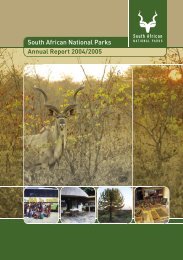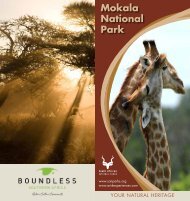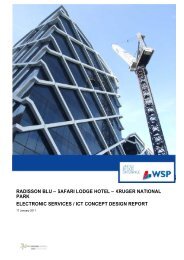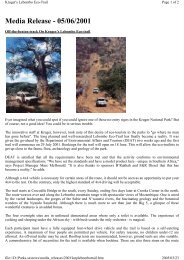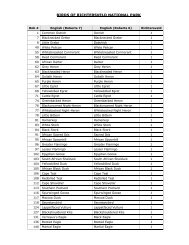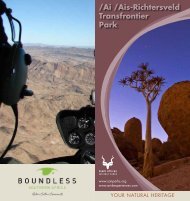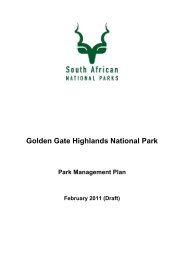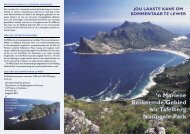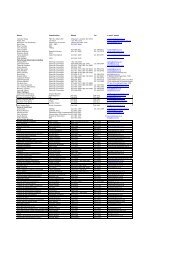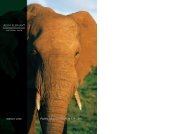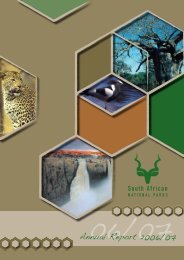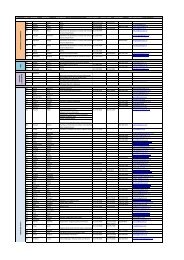PARKBESTUURSPLAN RICHTERSVELD ... - SANParks
PARKBESTUURSPLAN RICHTERSVELD ... - SANParks
PARKBESTUURSPLAN RICHTERSVELD ... - SANParks
Create successful ePaper yourself
Turn your PDF publications into a flip-book with our unique Google optimized e-Paper software.
and size of groups. Activities include hiking, 4x4 drives and game viewing. Access is controlled<br />
either through only allowing access to those with bookings for specific facilities, or<br />
alternatively through a specific booking or permit for a particular hiking trail or 4x4 route.<br />
Several groups may be in area at the same time, but access should be managed to minimize<br />
interaction between groups if necessary.<br />
Interaction with other users: Interaction between groups of users is low, and care must be<br />
taken in determining the number and nature of facilities located in the area in order to minimize<br />
these interactions.<br />
Objectives of the zone (Limits of acceptable change):<br />
Biophysical environment: Deviation from a natural/pristine state should be small and limited<br />
to restricted impact footprints. Existing impacts should be reduced. Any facilities constructed<br />
in these areas, and activities undertaken here should be done in a way that limits environmental<br />
impacts. Road and infrastructure specifications should be designed to limit impacts.<br />
Aesthetics and recreational environment: Activities which impact on the intrinsically wild<br />
appearance and character of the area, or which impact on the wilderness characteristics of<br />
the area (solitude, remoteness, wildness, serenity, peace etc) should be restricted and<br />
impacts limited to the site of the facility. Ideally visitors should only be aware of the facility<br />
or infrastructure that they are using, and this infrastructure/facility should be designed to fit<br />
in with the environment within which it is located in order to avoid aesthetic impacts.<br />
Facilities:<br />
Type and size: Facilities are small, often very basic, and are distributed to avoid contact<br />
between users. Alternatively facilities designed for high levels of luxury, but limited visitor<br />
numbers can be accommodated here (e.g. controlled access private camps or concession<br />
sites).<br />
Sophistication of facilities: Generally facilities are small, basic and self-catering, though concession<br />
facilities may be significantly more sophisticated.<br />
Audible equipment and communication structures: None.<br />
Access and roads: Vehicular access to facilities is limited to low-spec roads, often 4x4 only.<br />
Tourist and game viewing roads are 4x4 only. Established footpaths are provided to avoid<br />
erosion and braiding.<br />
Location in Park:<br />
In Richtersveld NP, Primitive areas were designated to buffer remote areas and to protect<br />
most of the remaining sensitive areas from high levels of tourism activity. The small controlled<br />
access accommodation facilities at Tatasberg, Kokerboomkloof, Gannakoeriep and the trail<br />
basecamp (as well as the access roads to these sites) were also included in this zone. Most<br />
lowland areas utilized for small-stock were included into this zone. In areas where Remote<br />
zones border on the park boundary, a 100m wide Primitive zone was designated to allow<br />
park management access to boundaries.<br />
Low Intensity Leisure Zone:<br />
Characteristics:<br />
The underlying characteristic of this zone is motorized self-drive<br />
access with basic self-catering facilities. The numbers of visitors<br />
are higher than in the Remote and Primitive zones. These<br />
camps are without modern facilities such as shops and restaurants.<br />
Relatively comfortable facilities are positioned in the<br />
landscape retaining its inherent natural and visual quality, which<br />
enhances the visitor experience of a more natural and self providing<br />
experience. Access roads are low key, preferably gravel<br />
roads and/or tracks to provide a more wild experience.<br />
Facilities along roads are limited to basic self-catering picnic<br />
sites with toilet facilities. In Richtersveld National Park, large<br />
busses and open safari vehicles are not permitted.<br />
Visitor activities and experience:<br />
Activities: Self drive motorized game viewing, picnicking, walking,<br />
cycling, hiking, adventure activities.<br />
Interaction with other users: Moderate to high<br />
Objectives of the zone (Limits of acceptable change):<br />
Biophysical environment: Deviation from a natural/pristine state<br />
should be minimized and limited to restricted impact footprints<br />
as far as possible. However, it is accepted that some damage to<br />
the biophysical environment associated with tourist activities<br />
and facilities will be inevitable.<br />
Aesthetics and recreational environment: Although it is<br />
inevitable that activities and facilities will impact on the wild<br />
appearance and reduction of the wilderness characteristics of<br />
the area (solitude, remoteness, wildness etc), these should be<br />
managed and limited to ensure that the area still provides a relatively<br />
natural outdoor experience.<br />
Facilities:<br />
Although many of these facilities are neither present nor anticipated<br />
in the Richtersveld NP, the zoning could accommodate<br />
them.<br />
Type and size: Picnic sites, view sites, information centres, ablution<br />
facilities, parking areas, education centres etc. Small selfcatering<br />
(including camping) camps of low to medium density<br />
25-35 beds. Additional facilities can include swimming pools.<br />
Trails for 4x4 trails can also be provided. Day visitor site are not<br />
placed within the camps. Day visitor sites must relate to the<br />
general self-catering characteristic of the zone.<br />
Sophistication of facilities: Self contained self-catering units<br />
with bathroom facilities. Camp sites will include ablution facilities.<br />
These camps are without modern facilities such as shops<br />
and restaurants.<br />
Audible equipment and communication structures: Cell phone<br />
coverage in vicinity of camps. Code of use for cell phones and<br />
radios required to retain relative level of solitude.<br />
Access and roads: Motorized self drive 4x4 access on designated<br />
routes which are graveled roads. The roads are currently not<br />
accessible to sedan vehicles, but the potential to make certain<br />
roads suitable to sedan vehicles should be investigated, in<br />
order to improve/increase access to the park for a wider variety<br />
of visitors.<br />
Location in Park:<br />
In Richtersveld NP, Low intensity leisure areas were designated<br />
along the current main access routes and to include facilities at<br />
Pooitjiespram and camping sites along the Gariep River. The<br />
edges of the Low intensity leisure zones were defined in terms<br />
of landscape sensitivity and value (as well as topographic) constraints,<br />
with most high sensitivity landscapes being excluded<br />
from this zone. In areas where the existing access routes go<br />
through areas of high environmental sensitivity (such as the<br />
mountain passes), the zoning was designed to prevent any<br />
expansion of facilities in these areas. In addition these areas<br />
were also included within a special conservation overlay in<br />
order to mitigate any ongoing impacts associated with these<br />
unavoidable access routes.<br />
Overview of the Special Management Overlays of<br />
Richtersveld National Park:<br />
Special management overlays which designate specific areas of<br />
the park that require special management interventions were<br />
identified (Figure One; Table Two). Two types of area were designated:<br />
Rehabilitation Areas: Areas along the Gariep River where current<br />
mining activities are occurring, or where mining occurred<br />
previously, were identified for eventual rehabilitation before<br />
they can be incorporated into the underlying tourist use zone.<br />
Special Conservation Area: Areas with concentrations of<br />
endangered, rare and endemic species, as well as areas with<br />
high overall environmental sensitivity and value were designated<br />
as Special Conservation Areas. These areas are subject to<br />
stricter environmental controls with regard to tourism and<br />
resource use impacts.<br />
THE PARK INTERFACE ZONE<br />
The Park Interface Zones shows the areas within which landuse<br />
changes could affect a national Park. The zones, in combination<br />
with guidelines, will serve as a basis for a.) identifying the focus<br />
areas in which park management and scientists should respond<br />
to EIA’s, b.) helping to identify the sort of impacts that would be<br />
important at a particular site, and most importantly c.) serving<br />
as the basis for integrating long term protection of a national<br />
park into the spatial development plans of municipalities<br />
(SDF/IDP) and other local authorities. In terms of EIA response,<br />
the zones serve largely to raise red-flags and do not remove the<br />
need for carefully considering the exact impact of a proposed<br />
development. In particular, they do not address activities with<br />
broad regional aesthetic or biodiversity impacts.<br />
The Park Interface Zone for Richtersveld NP has two overlaying<br />
categories, namely priority natural areas, and a visual/aesthetic<br />
zone (Map 6).<br />
Priority Natural Areas:<br />
This zone aims to ensure the long term persistence of biodiversity,<br />
within and around the park, by identifying the key<br />
R I C H T E R S V E L D N A S I O N A L E P A R K • P A R K B E S T U U R S P L A N<br />
86<br />
87



